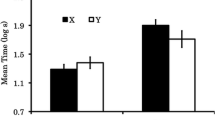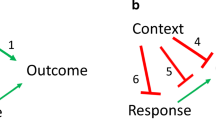Abstract
Minor tranquilizers typically fail to facilitate learned behaviors suppressed by CER or punishment. However, this study found a disruption of a temporal discrimination (Pavlovian Inhibition of Delay) based on conditioned suppression. After 230 trials for nine rats, greatest suppression occurred at the end of the CS (inhibition of delay). Drug, but not saline, disrupted this discrimination, and the data were interpreted in terms of Pavlovian excitation and inhibition.
Similar content being viewed by others
References
Berger, B. D., Margules, D. L., Stein, L.: Prevention of learning of a fear response by oxazepam and scopolomine. Amer. Psychol. 22, 492 (abstract) (1967).
Cicala, G. A., Hartley, D. L.: Drugs and the learning and performance of fear. J. comp. physiol. Psychol. 64, 175–178 (1967).
Davidson, A. B.: Facilitory effects of chlordiazepoxide on behavior of rats. Paper presented at the meeting of the 78th Ann. APA Conv., Miami Beach, Fla., September 1970.
Estes, W. K., Skinner, B. F.: Some quantitative properties of anxiety. J. exp. Psychol. 29, 390–400 (1941).
Hammond, L. J.: A traditional demonstration of the active properties of Pavlovian inhibition using differential CER. Psychonom. Sci. 9, 65–66 (1967).
—, Maser, J.: Forgetting and conditioned suppression: Role of a temporal discrimination. J. exp. Anal. Behav. 13, 333–338 (1970).
Leaf, R. C., Muller, S. A.: Simple method for CER conditioning and measurement. Psychol. Rep. 17, 211–215 (1965).
Margules, D. L., Stein, L.: Neuroleptics vs. tranquilizers: Evidence from animal studies of mode and site of action. In: H. Brill, ed.: Neuropsychopharmacology, 5th Internat. Cong. of Colleg. Internat. Neuropsychopharmacologicum. New York: Excerpta Medica Found 1967.
—: Increase of “Antianxiety” activity and tolerance of behavioral depression during chronic administration of oxazepam. Psychopharmacologia (Berl.) 13, 74–80 (1968).
Rescorla, R. A.: Pavlovian conditioning and it's proper control procedures. Psychol. Rev. 74, 71–80 (1967).
—, Lo Lordo, V. M.: Inhibition of avoidance behavior. J. comp. physiol. Psychol. 59, 406–412 (1965).
Scobie, S. R., Garske, G.: Chlordiazepoxide and conditioned suppression. Psychopharmacologia (Berl.) 16, 272–280 (1970).
Author information
Authors and Affiliations
Additional information
The authors acknowledge with appreciation the suggestions of David Margules and the contribution of oxazepam by Wyeth Laboratories. This research was supported by NIMH grants MH 16540 to LJH. Reprints may be obtained by writing to Jack D. Maser who is now at the Department of Psychology, Tulane University, New Orleans, Louisiana 70118.
Rights and permissions
About this article
Cite this article
Maser, J.D., Hammond, L.J. Disruption of a temporal discrimination by the minor tranquilizer, oxazepam. Psychopharmacologia 25, 69–76 (1972). https://doi.org/10.1007/BF00422618
Received:
Revised:
Issue Date:
DOI: https://doi.org/10.1007/BF00422618




